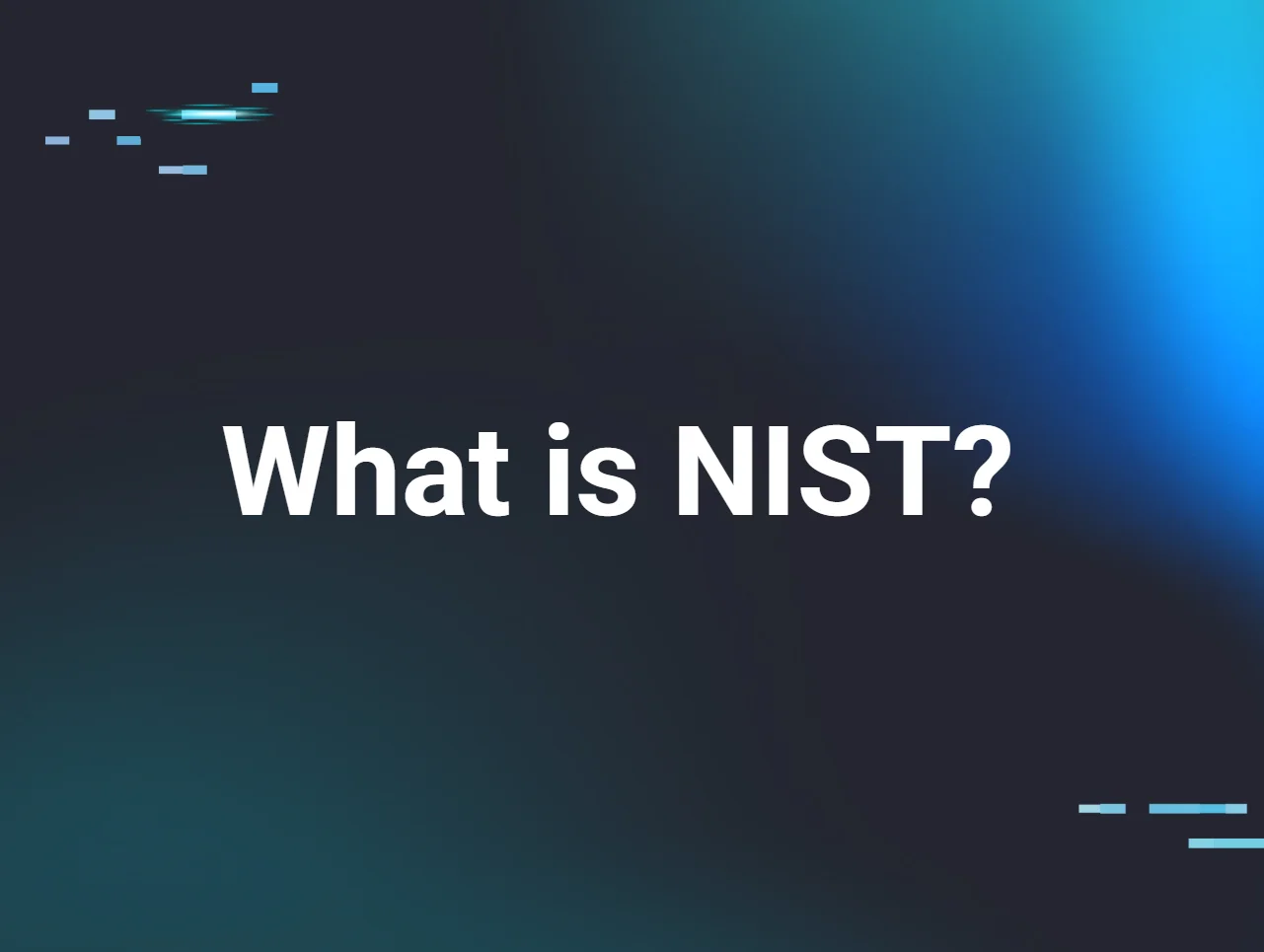Ever wondered who’s making sure your data stays secure, or who sets the gold standard for cybersecurity frameworks like the ones your company relies on daily? Say hello to NIST, the National Institute of Standards and Technology. NIST plays a pivotal role in shaping the tech landscape for businesses and government agencies alike.
From cybersecurity to risk management, NIST isn’t just another acronym in the tech world. It’s the backbone of trust, consistency, and reliability in tech systems across industries. Whether you’re a cybersecurity professional or an enterprise leader, understanding how NIST works could reshape the way you approach innovation and security.
In this guide, we will cover:
What is NIST?
If NIST had a tagline, it would probably be “Innovating with Precision.” Established in 1901, NIST is a non-regulatory agency operating under the U.S. Department of Commerce. Its mission? To promote innovation, industrial competitiveness, and economic stability by advancing science, technology, and standards.
Here’s the cheat sheet on NIST’s origins and what they aim to do:
-
History & Background
Founded as the National Bureau of Standards, NIST initially focused on basic measurements like weights and measures. It was rebranded in 1988 to better reflect its expanded scope.
-
Mission & Goals
NIST’s job is to promote American innovation by ensuring accurate, reliable standards and by helping businesses achieve global competitiveness. Think precise atomic clocks, encryption standards, and even advanced manufacturing tools.
-
Core Focus Areas
NIST is a game-changer in measurement science, technical standards, and cutting-edge technology, delivering real-world solutions to complex challenges. Part of NIST’s focus area includes cybersecurity, and the NIST Cybersecurity Framework helps companies improve risk management.
Why Does NIST Matter in Cybersecurity?
NIST has a big reputation for digging deep into cybersecurity problems and creating frameworks to tackle them. Whether you realize it or not, they've probably influenced how your organization runs IT security. Here’s how NIST is making the digital world safer and smarter:
-
Building Standards That Matter
The NIST Cybersecurity Framework sets guidelines for how organizations secure networks, handle sensitive data, and mitigate risks. These standards ensure everyone—from startups to federal agencies—is on the same page.
At Huntress, we use these standards to…
-
A Global Cybersecurity Ally
Collaborating with governments, universities, and private companies worldwide, NIST shapes best practices that transcend borders and industries. No wonder organizations worldwide rely on their robust frameworks.
-
Driving Innovation in Risk Management
Remember the last time you gave a presentation on cyber risks? Odds are, something you discussed ties directly back to NIST's research or risk management guidelines. The NIST Cybersecurity Framework makes navigating the murky waters of cyber risk much easier.
Key NIST Cybersecurity Frameworks and Tools
NIST might not have a TikTok, but trust us, their tools are trending worldwide in the cybersecurity community. Here’s how they help professionals stay ahead of the game:
1. NIST Cybersecurity Framework (CSF)
This bad boy is the holy grail for any organization managing cybersecurity risks. The CSF is a voluntary framework split into five steps (fancy, right?):
Identify → Protect → Detect → Respond → Recover.
Think of it as a blueprint you can scale for your small business or a multinational enterprise.
Where does the CSF really shine?
-
Critical Infrastructure Protection
It’s a go-to for industries like energy or finance that need airtight, reliable security measures.
-
Versatility
Whether you’re securing your tech stack or aligning with regulatory needs, this framework has you covered.
2. NIST Special Publications (SP)
The NIST 800 series might sound like a Marvel universe spin-off, but it’s actually a collection of guides that keep cybersecurity pros ahead of the curve. Here's a quick breakdown:
-
SP 800-53
Security and privacy controls for federal information systems. It’s robust, comprehensive, and mandatory for federal contractors.
-
SP 800-171
Guidance for protecting controlled unclassified information, especially vital for contractors working with sensitive U.S. government data.
3. NIST Risk Management Framework (RMF)
Not all risks are created equal, and neither is every enterprise’s response. That’s why NIST created the RMF, a step-by-step guide to identifying, mitigating, and managing risks for IT systems.
Steps include everything from categorizing systems to ongoing monitoring, ensuring businesses can adapt to threats without skipping a beat.
How NIST Standards Show Up in Everyday Business
The magic of NIST isn’t just for government agencies. It powers a huge variety of real-world applications:
- Compliance Measures: Federal frameworks like FISMA, DFARS, and FedRAMP are rooted in NIST guidelines, which makes them the industry standard for compliance in industries ranging from healthcare to banking.
- Enterprise Adoption: Organizations across sectors, from retail to advanced manufacturing, use NIST’s CSF to strengthen their security postures. Think fewer breaches and happier stakeholders.
If your company still isn’t aligning with NIST, here’s what you’re missing out on:
-
Consistency Across the Board
NIST makes sure diverse teams and systems can work together seamlessly. Say goodbye to miscommunications and inefficiencies.
-
Better Risk Strategies
Organizations using NIST guidelines tend to come out stronger when facing cyber threats. Know the risks → adapt → and always stay ready for the worst.
-
Trust and Accountability
Using internationally recognized standards signals to customers and partners that you take cybersecurity seriously.
-
Regulatory Compliance, Simplified
Adopting NIST frameworks prepares you to meet regulatory landscapes head-on with minimal friction.
Limitations to Keep in Mind
But hey, no framework is perfect, and NIST is no exception. Watch out for:
-
Complexity: NIST’s guidelines can feel a bit dense for organizations without dedicated IT teams.
-
Custom Fit Required: The “one-size-fits-all” concept doesn’t work here. Tailoring NIST frameworks to your needs takes both time and resources.
-
Implementation Challenges: The deeper your needs, the more daunting implementing these standards can feel—for both small businesses and global conglomerates alike.
The Future of NIST in Cybersecurity
What’s next for NIST? Buckle up, because the future is exciting:
-
Focus on Zero Trust: With security needs evolving, NIST is doubling down on next-gen frameworks like Zero Trust Architecture.
-
Leadership in Quantum Security: With the advent of quantum computing, NIST’s role in standardizing quantum-resistant encryption will be groundbreaking.
Empower Your Cybersecurity Frameworks with NIST
The National Institute of Standards and Technology might not have a flashy logo or a million Instagram followers, but what it offers is way more significant. For cybersecurity professionals, aligning with NIST standards isn’t just a nice-to-have; it’s a strategic advantage that can fundamentally enhance how you operate.
Feeling inspired? Start exploring NIST frameworks for cybersecurity, risk management, and beyond by clicking here.
NIST stands for the National Institute of Standards and Technology.
No, but aligning with their frameworks can help meet compliance standards and improve cybersecurity.
NIST is U.S.-specific, while ISO standards are international. Both uphold high standards but serve different ecosystems.




Protect What Matters







